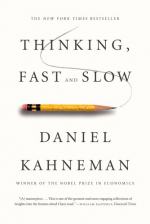
|
| Name: _________________________ | Period: ___________________ |
This test consists of 15 multiple choice questions and 5 short answer questions.
Multiple Choice Questions
1. The author conludes in Chapter 10 that humans pay more attention to the content of messages than to what?
(a) Information about their reliability.
(b) Information about their connection with self.
(c) The statistics behind them.
(d) Their causality.
2. In one example provided for the reader, Kahneman instructs to draw one line, 2 1/2 inches from the bottom of a sheet of paper. On a second sheet, the subject is to draw a 2 1/5 line from the top. What are his observations regarding the lines?
(a) Both lines will be divergent but correct.
(b) The line from the bottom will be more accurate.
(c) Both lines will be equally accurate.
(d) The line from the top will be more accurate.
3. Who was Richard Nisbett's student who assisted in conducting an experiment at the University of Michigan that the author cites in Chapter 15?
(a) Eugene Borgida.
(b) John List.
(c) Gary Klein.
(d) Christopher Hsee.
4. Who wrote Strumbling to Happiness?
(a) Danny Oppenheimer.
(b) Daniel Gilbert.
(c) Larry Jacoby.
(d) Shane Frederick.
5. Who wrote The Invisible Gorilla?
(a) Larry Jacoby.
(b) Christopher Chabris and Daniel Simons.
(c) Nassim Taleb.
(d) Mihaly Csikszentmihalyi.
6. Where did Kahneman and Tversky present their Linda study to doctoral students in the decision-science program?
(a) Harvard University School of Business.
(b) Stanford Graduate School of Business.
(c) New York University School of Business.
(d) Princeton University School of Business.
7. Who created the Remote Association Test to study creativity?
(a) Daniel Gilbert.
(b) Shane Frederick.
(c) Samoff Mednick.
(d) Danny Oppenheimer.
8. In the presentation of the "character" of Tom W. in Chapter 14, what is the subject of the experiment asked to rate?
(a) At what age Tom gets married.
(b) How old Tom is.
(c) What job Tom has.
(d) What Tom's major is in college.
9. The author states that people's predilection for causal thinking exposes them to serious mistakes in evaluating what?
(a) The randomness of truly random events.
(b) The causality of events.
(c) The merits of analytical analysis.
(d) The different values of statistics.
10. What does the author claim the main function of System 1 is in Chapter 6?
(a) To grasp large concepts in relation to small concepts.
(b) To categorize numbers and letters and find associations between them.
(c) To maintain and update a model for one's personal world.
(d) To calculate difficult problems such as math equations.
11. What term refers to an approach to problem solving that employs a practical method not guaranteed to be perfect, but sufficient for the immediate goals?
(a) Illusion.
(b) Causality.
(c) Heuristic.
(d) Executive control.
12. Who coined the term "mere exposure effect"?
(a) Daniel Gilbert.
(b) Danny Oppenheimer.
(c) Shane Frederick.
(d) Robert Zajonc.
13. With whom did Daniel Kahneman conduct a study on pupil dilation at the University of Michigan?
(a) Mihaly Csikszentmihalyi.
(b) Larry Jacoby.
(c) Nassim Taleb.
(d) Jackson Beatty.
14. What term did Sunstein and Kuran invent for the mechanism through which biases flow into policy?
(a) The Moses Illusion.
(b) The availability cascade.
(c) An anchoring effect.
(d) Cognitive Pupillometry.
15. According to the author, what is determined by the coherence of the best story you can tell by the evidence at hand?
(a) Ego depletion.
(b) Executive control.
(c) Confidence.
(d) Axioms.
Short Answer Questions
1. What does the author describe seeing on a drive from New York to Princeton that surprised him and his wife in Chapter 6?
2. In conducting their wheel of fortune study, Kahneman and Tversky set their wheel to only stop on what numbers?
3. The average effort of System 2 is repeatedly compared with what?
4. Who is described as the editor for the online magazine Edge that asked scientists to report their favorite equation?
5. In the experiment conducted at the University of Michigan by Richard Nisbett, how many of the 15 participants responded immediately to the stooge's plea for help?
|
This section contains 601 words (approx. 3 pages at 300 words per page) |

|




